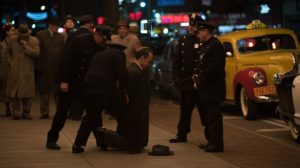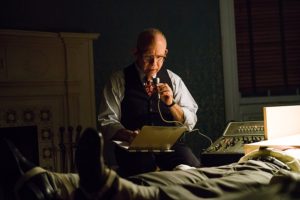 Uncovering some of the U.S. government’s darkest secrets, “Wormwood,” currently on Netflix, examines the life-long quest of one man–Eric Olson–to find the truth behind his father’s mysterious death. Weaving this mystery into a six-part story, renowned documentarian Errol Morris (Fog of War, Thin Blue Line) combines his own noted interview style with a dramatic narrative anchored by Peter Sarsgaard’s stellar performance as mild-mannered military scientist Frank Olson, the man who plunged to his death from a New York hotel window. The thriller and mystery components of this true story appealed to Morris who was drawn to the “odd combination of drugs and murder.”
Uncovering some of the U.S. government’s darkest secrets, “Wormwood,” currently on Netflix, examines the life-long quest of one man–Eric Olson–to find the truth behind his father’s mysterious death. Weaving this mystery into a six-part story, renowned documentarian Errol Morris (Fog of War, Thin Blue Line) combines his own noted interview style with a dramatic narrative anchored by Peter Sarsgaard’s stellar performance as mild-mannered military scientist Frank Olson, the man who plunged to his death from a New York hotel window. The thriller and mystery components of this true story appealed to Morris who was drawn to the “odd combination of drugs and murder.”
 To bring the story to the screen, Morris used a variety of archival materials—newspaper clippings, photos, newsreels, and old cinema segments. Shooting with up to ten different camera angles on Eric, Morris built the story from interviews that follow Eric’s 60-year path of discovery. In place of the reenactments used in a conventional documentary and to illustrate the events of the underlying story, Morris used sequences more akin to scripted drama. The result is a stylistic hybrid of documentary and dramatic mini-series. “The drama is straight drama, and really quite different in character than reenactments. “Fortunately, because of Netflix, I had a big enough budget to create this movie with all of the diverse elements I wanted in it.”
To bring the story to the screen, Morris used a variety of archival materials—newspaper clippings, photos, newsreels, and old cinema segments. Shooting with up to ten different camera angles on Eric, Morris built the story from interviews that follow Eric’s 60-year path of discovery. In place of the reenactments used in a conventional documentary and to illustrate the events of the underlying story, Morris used sequences more akin to scripted drama. The result is a stylistic hybrid of documentary and dramatic mini-series. “The drama is straight drama, and really quite different in character than reenactments. “Fortunately, because of Netflix, I had a big enough budget to create this movie with all of the diverse elements I wanted in it.”
Because of the number of people who participated in making the film, Morris believes that “Wormwood” is “very much a below the line kind of movie.” For twenty years Morris has collaborated with editor Steven Hathaway, who was tasked with piecing together the complicated story from vast amounts of footage. “Steven worked tirelessly editing, and provided the post production supervision, including supervision of all visual effects,” stated Morris. “And, if that wasn’t enough, he also co-wrote the script. Molly Rokosz, one of our researchers was another co-writer along with Kieran Fitzgerald.”
 Partially because of the mini-series format, partially due to the complicated nature of the story, the script repeated dramatic sequences, with new scenes being added as Eric revealed the additional information he discovered about the events leading up to and following his father’s death. In shaping the story, Morris took his cue from “Sopranos” and “House of Cards,” episodic television with similar introductory elements that were repeated again and again, which became familiar story components to the viewer. To tell this particular story, Morris also took into account the evolution of film and changes such as aspect ratios, length of features, how and where films are exhibited, and the effect these variations have on the art form. With new media, there is a different set of rules. “People may be watching it in installments. You want to keep them oriented in the story. You want to provide cliffhangers so at the end of any installment, they want to watch more,” explained Morris. “Part of the deal in creating a different format, which Netflix has done, is how we view media; how we receive media. Now it’s not just television and movies. It’s a completely different force in all of this. You can pretend it isn’t, but it is.”
Partially because of the mini-series format, partially due to the complicated nature of the story, the script repeated dramatic sequences, with new scenes being added as Eric revealed the additional information he discovered about the events leading up to and following his father’s death. In shaping the story, Morris took his cue from “Sopranos” and “House of Cards,” episodic television with similar introductory elements that were repeated again and again, which became familiar story components to the viewer. To tell this particular story, Morris also took into account the evolution of film and changes such as aspect ratios, length of features, how and where films are exhibited, and the effect these variations have on the art form. With new media, there is a different set of rules. “People may be watching it in installments. You want to keep them oriented in the story. You want to provide cliffhangers so at the end of any installment, they want to watch more,” explained Morris. “Part of the deal in creating a different format, which Netflix has done, is how we view media; how we receive media. Now it’s not just television and movies. It’s a completely different force in all of this. You can pretend it isn’t, but it is.”
Morris admits that over the years, technology has influenced everything he’s done in very dramatic ways. Without an Avid, it would have been impossible to edit the different formats and split screens used in the film into a seamless whole. “Wormwood” would have been impossible without Netflix and streaming media. Morris thinks these changes constitute a new form of expression not yet fully comprehended. Always willing to experiment, Morris’ films do not always conform to the boxes society or institutions want to fit them into. The motion picture academy rejected “Wormwood” for consideration in the feature documentary category, although it could be considered for other awards.
It took two years to complete “Wormwood,” not an excessive amount of time considering the length of the final series. The interviews were shot and edited before the scripted narrative was shot. Throughout the process, they were creating more and more graphic material. Home movies by Frank Olson were transferred to 5 K. The team found all kinds of film clips from obscure places that, as the filmmakers discovered new material, kept coming in until the very end.
The Colby documents formed the basis for the drama. Based upon CIA lies, the records told “a kind of crazy story,” that didn’t quite make sense. The papers contained contradictory information, but Morris discovered that Olson might have attended a performance of Roger and Hammerstein’s, “Me and Juliette,” with his government minders. That piece of information gave the filmmakers the opportunity to include a Broadway musical in the story. They also garnered information about Frank Olson’s fears that the police were going to arrest him outside the theater, and about the LSD dosing at Deep Creek. All of that came from those documents.
Two central figures in the production of the film were cinematographers Igor Martinovic and Ellen Kuras. Morris worked with Martinovic on two episodes of the television series, “It’s Not Crazy, It’s Sports.” “I’m a complete fan of Igor,” stated Morris. “A couple of days into the shooting, I told him you didn’t warn me you were an artist. How dare you! Both Igor and Ellen are brilliant.” Kuras walked into one environment, an abandoned office building, and had a clear idea where she wanted to put the ten cameras they used. During production she was constantly adjusting cameras, reframing. “And that’s not an task. How do you avoid catching one of the cameras in your shot? None of the cameras see any of the other cameras. It was an amazing feat on its own. Ellen did great. She’s fearless actually.”
According to Morris, “crossing the line” works great in interviews, and can even build a sense of drama when used in the narrative. “When Peter goes out the window on the set we built in Brooklyn, we crossed the line,” he explained. “We put the camera on one side of him, and the other side, and that’s crossing the line. You still see him go out the window. You know what is happening, but it adds tension and drama.” He shared he was “very much obsessed with framing.” Very deliberate in his process, he does not like a lot of camera motion, using handheld only when needed, such as to convey the LSD experiences or when Olson goes crazy outside the theater.
First assistant director Atilla Salih Yücer, was “invaluable” to the production. He believed in the project and fought to make it happen. “How many people have a Turkish A.D. called Atilla?” quipped Morris. “He was an inspiration. He kept me in line and understood what I was trying to achieve. He worked endlessly to allow me to realize this movie. I was blessed by a great crew, not to mention the actors.”
Production design was by Tommaso Ortino and costume design by Catherine Riley. Paul Leonard-Morgan, already a collaborator of Morris’, was tapped to create the suspenseful score. Jerry Spivack supervised visual effects. Morris credits all his crew with going above and beyond, “It’s amazing that we actually produced this and that it looks so truly excellent. Anybody who makes movies–it doesn’t matter what genre–everybody knows how one weak crewmember could destroy a whole project. Success depends on everyone uniting.”
“Wormwood” is opening at the Laemmle Music Hall in LA, as well as the Metrograph in NY, and launching on Netflix on Friday, December 15th.





